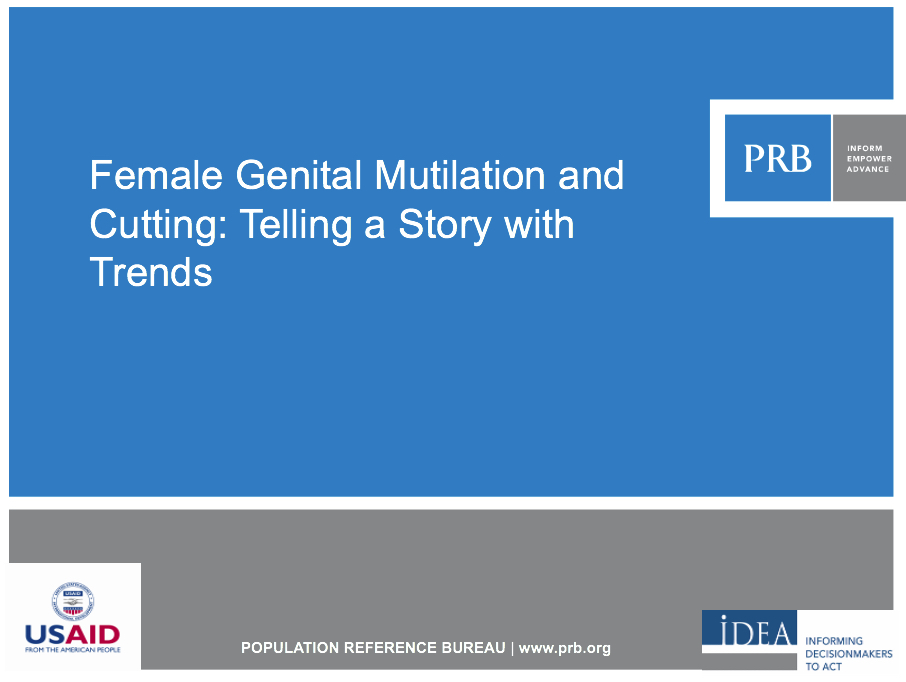
2011 International Day of Zero Tolerance to Female Genital Mutilation/Cutting
Date
February 1, 2011
Author
Focus Area
(February 2011) Drawing on PRB’s data sheet Female Genital Mutilation/Cutting: Data and Trends, 2010 Update, this PowerPoint presentation is designed to bring attention to and present accurate data on this practice that affects millions of women and young girls worldwide. The presentation includes an overview of the topic, definitions, and data comparisons within and among countries, as well as trends. Notes are included as a presentation aid.this PowerPoint presentation is designed to bring attention to and present accurate data on this practice that affects millions of women and young girls worldwide. The presentation includes an overview of the topic, definitions, and data comparisons within and among countries, as well as trends. Notes are included as a presentation aid. This PowerPoint presentation is designed to bring attention to and present accurate data on this practice that affects millions of women and young girls worldwide. The presentation includes an overview of the topic, definitions, and data comparisons within and among countries, as well as trends. Notes are included as a presentation aid., this PowerPoint presentation is designed to bring attention to and present accurate data on this practice that affects millions of women and young girls worldwide. The presentation includes an overview of the topic, definitions, and data comparisons within and among countries, as well as trends. Notes are included as a presentation aid.
Feb. 6, 2011, marks the ninth International Day of Zero Tolerance to Female Genital Mutilation/Cutting. An estimated 100 million to 140 million girls and women worldwide have undergone female genital mutilation/cutting (FGM/C) and more than 3 million girls are at risk for cutting each year on the African continent alone.
Zero Tolerance Day originated on Feb. 6, 2003, when the first lady of Nigeria, Mrs. Stella Obasanjo, officially declared “Zero Tolerance to FGM” in Africa during a conference organized by the Inter-African Committee on Traditional Practices Affecting the Health of Women and Children (IAC), a nongovernmental network headquartered in Addis Ababa, Ethiopia. Since then, this day has been observed around the world. As we commemorate Feb. 6, we should acknowledge the bravery of those who first spoke out against it and recent hard-won successes, but also recognize the still-overwhelming challenges, and those leaders who are continuing to work on the front lines to bring about change.
In West Africa, human rights campaigners have been struggling for years to eliminate the practice. In Mauritania, where 72 percent of women have been cut, there is now a consensus among doctors in the country that the practice threatens women’s health. Citing this consensus, a group of 34 Muslim clerics and scholars in Mauritania recently declared a fatwa, or religious decree, against FGM/C. The group stated that it is clear Islam is against cutting and the practice should be discontinued. The government of Mauritania also supports this decision. Many leaders have agreed to preach against the practice in their mosques.
Just over a year ago, Uganda’s parliament unanimously passed a bill outlawing FGM/C. According to the bill, convicted offenders face 10 years in prison, but if the girl dies during the act, those involved will receive a life sentence. The bill was only a first step, however. One member of parliament suggested that, in the future, the bill may be amended to include compensation for women subjected to the practice. Uganda has now gone further and called for all of Africa to stop the practice. The country’s state minister for gender has called for a widespread ban, emphasizing that the current law will be most successful if neighboring countries also discontinue the practice.
Yet, challenges remain, even within countries where advances have been realized. While Uganda’s law is a huge step forward and can be viewed as a model for the region, there are still girls in Uganda’s rural areas who continue to be cut. And although Sierra Leone’s government has stated that it would ban FGM/C, it has yet to do so. Ninety-four percent of women in the country have been cut, and four female reporters were abducted by supporters of FGM/C who accused the reporters of insulting their traditions by criticizing the practice. The reporters were forced to march naked through a city street before being released.
In contrast, neighboring Gambia’s Committee for Traditional Practices (GAMCOTRAP) has been defending gender issues and human rights for 30 years and has been very effective in the promotion of women’s and children’s rights, especially relating to FGM/C. Their tireless efforts have led to over 100 circumcisers dropping their knives publicly and abandoning the practice. In the last year, two of GAMCOTRAP’s top leaders were arrested on questionable charges that led many in Gambia to express support for the two leaders and to speak out against the imposition of greater control and restrictions on nongovernmental organizations (NGOs).
Increasingly, media, NGOs, and community leaders are speaking out against this harmful traditional practice. The flow of information is critical to this effort. In the coming year, the anticipated release of new Demographic and Health Surveys from countries such as Burkina Faso, Cote d’Ivoire, Senegal, Tanzania, and Yemen will provide valuable details on the current situation and what obstacles lie ahead.
Donna Clifton is communications specialist, International Programs, and Charlotte Feldman-Jacobs is program director, Gender, at the Population Reference Bureau.

 ">
">